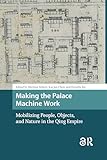Making the Palace Machine Work Mobilizing People, Objects, and Nature in the Qing Empire
Material type: ArticleLanguage: English Publication details: Amsterdam University Press 2021Description: 1 electronic resource (347 p.)ISBN:
ArticleLanguage: English Publication details: Amsterdam University Press 2021Description: 1 electronic resource (347 p.)ISBN: - 9789463720359
- 9789048553228
| Item type | Current library | Collection | Shelving location | Call number | Status | Notes | Date due | Barcode |
|---|---|---|---|---|---|---|---|---|
| Electronic edition | Bucheon University Library | History | OAPEN | 94 M20 | Not for loan | Смотреть (pdf) | 1009633 |
Open Access star Unrestricted online access
This volume brings the studies of institutions, labour, and material cultures to bear on the history of science and technology by tracing the workings of the Imperial Household Department (Neiwufu) in the Qing court and empire. An enormous apparatus that employed 22,000 men and women at its heyday, the Department operated a "machine" with myriad moving parts. The first part of the book portrays the people who kept it running, from technical experts to menial servants, and scrutinises the paper trails they left behind. Part two uncovers the working principles of the machine by following the production chains of some of its most splendid products: gilded statues, jade, porcelain, and textiles. Part three tackles the most complex task of all, managing living organisms in nature, including lotus plants grown in imperial ponds in Beijing, fresh medicines sourced from disparate regions, and tribute elephants from Southeast Asia.
Creative Commons by-nc-nd/3.0 cc
English




There are no comments on this title.